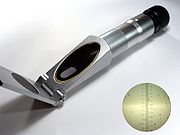
Traditional handheld refractometer
Encyclopedia

Refractive index
In optics the refractive index or index of refraction of a substance or medium is a measure of the speed of light in that medium. It is expressed as a ratio of the speed of light in vacuum relative to that in the considered medium....
. It works on the critical angle principle by which lenses and prisms project a shadow line onto a small glass reticle inside the instrument, which is then viewed by the user through a magnifying eyepiece.
In use, a sample is placed between a measuring prism and a small cover plate. Light traveling through the sample is either passed through to the reticle or totally internally reflected
Total internal reflection
Total internal reflection is an optical phenomenon that happens when a ray of light strikes a medium boundary at an angle larger than a particular critical angle with respect to the normal to the surface. If the refractive index is lower on the other side of the boundary and the incident angle is...
. The net effect is that a shadow line forms between the illuminated area and the dark area. It is where this shadow line crosses the scale that a reading is taken. Because refractive index is very temperature dependent, it is important to use a refractometer with automatic temperature compensation. Compensation is accomplished through the use of a small bi-metallic strip
Bi-metallic strip
A bimetallic strip is used to convert a temperature change into mechanical displacement. The strip consists of two strips of different metals which expand at different rates as they are heated, usually steel and copper, or in some cases brass instead of copper. The strips are joined together...
that moves a lens or prism in response to temperature changes.

